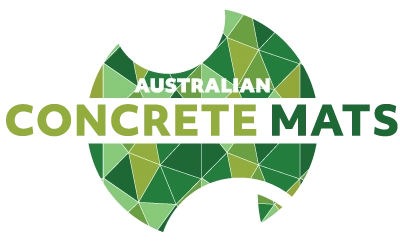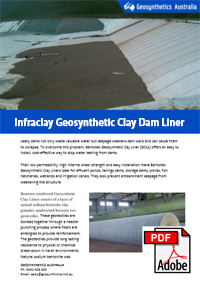Geosynthetics Australia supplies commercial quantities of Infraclay Geosynthetic Clay Liner (GCL) to civil contractors for major projects.
Our GCL is manufactured to international standards from natural sodium bentonite. This advanced bentonite clay waterproofing liner is made by interlocking a uniform layer of high swelling bentonite clay between two high strength geotextiles. Geosynthetics Australia’s Infraclay Liner delivers superior hydraulic performance over conventional compacted clay liners.
Using precision needle punching, non-woven geotextile fibres are punched through a layer of bentonite granules and into a woven propropylene carrier fabric beneath. This results in a uniform, shear resistant, waterproof liner with self-sealing characteristics.
Geosynthetic Clay Liner Applications:
When hydrated with water, bentonite clay forms a low permeability gel layer well suited for landfill liners, landfill caps and closures, backfilled walls, grain storage, liquid containment bunds, cut off trenches, effluent ponds, dams, lagoons and tunnels. Geosynthetic Australia’s Infraclay GCL has been used in major projects in China, Europe, South America, Papua New Guinea, New Zealand and Australia.
Landfill liners and caps
Dams, ponds and bunds
Construction: basements and tunnels
Special applications
Features of Geosynthetics Australia’s Infraclay Liner:
- Production facilities are CodeMark and Branz accredited.
- All products are fully guaranteed from manufacturing defects.
- When working in confined spaces, granulated bentonite clay liners offer Occupational Health and Safety benefits compared to powdered bentonite liners.
- The black woven layer facilitates visual checking of the stitching quality when the geosynthetic clay liner is being laid.
- Available in grades from 3500g/m2 to 5500g/m2 with or without a bonded PE membrane.
- Rolled on strong corrugated HDPE cores.
- Available in roll widths from 1.65m to 5.8m.
- Production capacity of 7.5 million m2/year.
- Direct shipping to major Australian ports, thus saving transport costs.
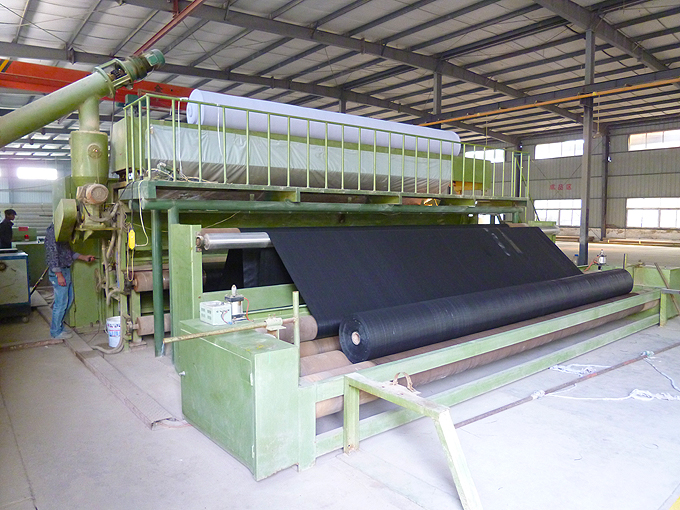
Geosynthetic Clay Liner manufacturing plant
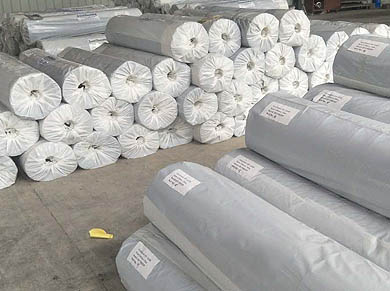
Geosynthetic clay liner for basement waterproofing
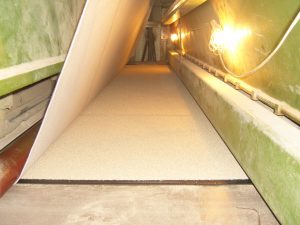
Sodium bentonite granules laid on woven carrier geotextile prior to needle punching
| Test Standard | Units | Grade | |
|---|---|---|---|
| Bentonite | GCL-4000 | ||
| Swell Index | ASTM D-5890 | ml/2g | > 24 |
| Fluid Loss | ASTM-D-5891 | ml | < 16 |
| Moisture Content | ASTM D-4643 | % | < 13 |
| Coefficient of Water Absorption | ASTM D-4643 | % | > 600 |
| Geotextiles | |||
| Polypropylene Cover (non-woven) | ASTM D 5261 | g/m2 | 220 |
| PP Carrier (woven) | ASTM D 5261 | g/m2 | 100 |
| Geosynthetics Australia GCL (as manufactured)* | |||
| Quality Assurance | ISO 9001; Branz NZ; CodeMark | Yes | |
| GCL Total Mass | ASTM D-5993 | g/m2 | > 4500 |
| Bentonite Mass | ASTM D-5993 | g/m2 | > 4200 |
| GCL Rupture Intensity Strength | ASTM D-6768 | kN/m | > 10.4 |
| Grab Strength (MD/CMD) | ASTM D-4632 | N | > 600/800 |
| CBR Strength | GB/T 14800-1993 | N | > 1800 |
| CBR Elongation | GB/T15788-1995 | % | > 15 |
| Peel Strength | ASTM D-6496 | N | > 120 |
| Hydraulic conductivity k-value (Permeability) |
ASTM D-5887 | m/s | < 5×10-10 |
| Dimensions – can be varied according to customer’s requirements | |||
| Width | m | 5.1 | |
| Length | m | 30 | |
| Effective Coverage per Roll (5.1m x 30m excluding overlap requirements) |
m2 | 153 | |










